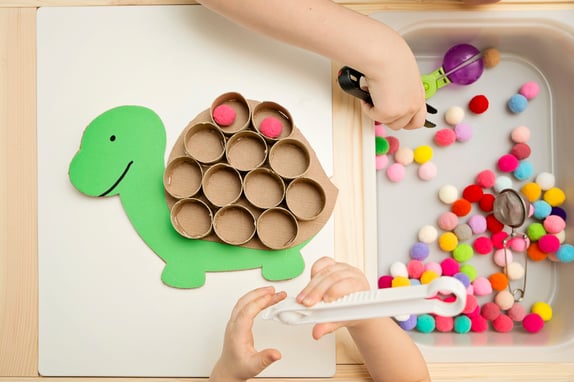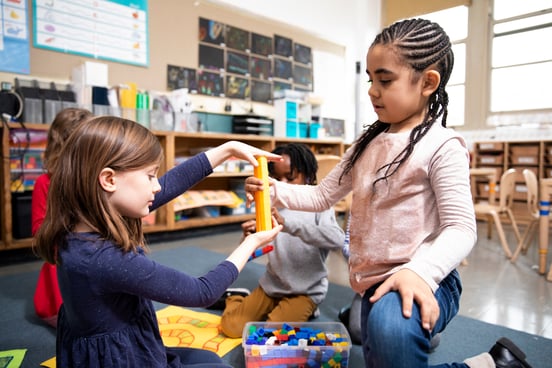
Math Assessment in California Schools: The Shift Toward Differentiated Instruction
Math assessment in California is changing. What used to be a compliance exercise or reporting tool is now becoming a...
ALI Staff | Published December 04, 2023 | Updated October 16, 2024
When you're working with two- and three-year-olds, play is how they learn best. Every time they count toy animals, stack blocks, or sort colorful shapes, it's a chance to introduce early math concepts like counting, grouping, or comparing sizes.
So, what exactly is mathematical play? It’s about taking the activities preschoolers already enjoy—whether it’s playing with puzzles, pretending to run a store, or measuring sand in the sandbox—and turning those moments into opportunities for math. For example, you can guide them to count out change when they "sell" items in their pretend store. Or, if they’re filling different-sized containers with sand, you can help them explore concepts like volume and comparison.
The best part? Young learners won’t even realize they’re learning math because they’re too busy having fun. They’re playing, but they’re also developing early childhood mathematics skills that will set them up for more complex concepts down the road.

Mathematical play isn’t just about making learning fun—it’s also a powerful way to help young learners develop a deeper mathematical understanding. For two- and three-year-olds, play gives them a hands-on experience with math concepts that they can see and feel. And each playful activity builds a foundation for later math skills.
When learners engage in math lessons through play, they’re doing more than just playing games. They’re actively exploring patterns and colors, learning to compare, and even solving basic problems without realizing it.
The long-term impact? This kind of play helps preschoolers develop the critical thinking skills they’ll need not just for math, but also for future STEM fields. As they engage with math in a playful, low-pressure environment, they start to build confidence in their abilities. Over time, this confidence grows, allowing them to approach math challenges head-on, knowing they’ve already laid a strong foundation through mathematical play.
When it comes to engaging young learners, incorporating math into play and everyday activities is one of the easiest and most effective ways to teach mathematics. The goal? Make it feel natural and fun so learners stay curious and excited about math.
Pretend play is a natural way to introduce math for children, helping them engage with early math concepts. Whether they’re playing store, setting up a pretend tea party, or running a make-believe farm, these activities offer opportunities for counting, sorting, and problem-solving. For example, learners can count out toy coins, decide how many plates are needed for their guests, or group animals by size. By embedding math into pretend scenarios, learners engage in preschool math fun while building a solid foundation in basic math concepts.
Using blocks, beads, or other physical objects helps learners “see” math concepts. Whether it’s counting, adding, or grouping items for early multiplication, these hands-on tools make abstract math ideas easier to grasp. Plus, learners love the interactive nature of these math activities, which help solidify their understanding.
Stories bring numbers to life. Introducing characters with math problems to solve shows learners how math is part of everyday life. It makes math more relatable, turning abstract concepts into real-world situations.
Rhythm and math go hand in hand. Clapping to a beat or singing along to songs helps learners recognize patterns and sequencing while having a blast. Songs and rhythm-based learning are simple but powerful tools in your ways to teach mathematics toolbox.
You don’t have to wait for formal lessons to teach math. Everyday routines offer endless opportunities. Counting plates at snack time, matching chairs to the number of students, or sorting toys during clean-up are all great math activities that fit seamlessly into the day.
By weaving math into play and daily activities, preschoolers will begin to see it as part of their world—not just something they learn in class.
The approach to teaching math through play is most effective when it's tailored to the math developmental stages of the child.
Here's how educators can adapt activities for different age groups, ensuring that learning is both age-appropriate and engaging.
Toddlers are naturally curious, and simple activities can harness this curiosity for mathematical discovery:
As children grow, they're ready to expand their understanding through slightly more complex games and activities:
Everyday activities are a treasure trove of opportunities for integrating math into a child's life. These experiences can make math feel less like a subject and more like a part of the child's natural world.
Here are some ways educators can incorporate math activities into routine classroom routines:
By weaving math into the fabric of daily routines, educators can help children see the usefulness and presence of math in everything they do, fostering a positive and inquisitive approach to the subject.
Introducing the right math language early on plays a huge role in shaping young learners' mathematical understanding. The terms you use can make math feel more approachable and less intimidating, helping learners grasp concepts they’ll build on in the future.
Using math-related words during playtime can take learning to the next level. While learners are building with blocks, for example, you can introduce terms like "taller," "shorter," "above," and "below." During sorting games, words like "more," "less," "equal," and "different" help learners make connections between these terms and real-world objects. It’s a fun way to turn abstract ideas into something concrete that preschoolers can easily understand.
Stories and group discussions are another great way to introduce math vocabulary. Words like "first," "second," "before," "after," "add," and "subtract" give learners the chance to practice these concepts in a meaningful, everyday context. Asking questions like, “Which tower is taller?” or “Can you divide these crayons equally?” encourages learners to think mathematically and apply what they’ve learned in a practical way.
Educators are key in this process. By consistently using math language during play and activities, you help learners build a strong foundation in mathematical literacy. This not only improves their immediate comprehension but also prepares them for more complex math down the road.
Teaching math in early childhood calls for a blend of strategy, patience, and creativity. Here are some of the best practices educators can use to create a positive, engaging learning experience for their preschoolers.
It’s normal for young learners to face challenges with math, whether they’re struggling with disinterest or finding certain concepts tricky. The key to overcoming these obstacles is recognizing that every student has their own unique learning style. Using a variety of methods—like visual aids, hands-on activities, and storytelling—helps make children's math lessons engaging and adaptable to different types of learners.
Group activities where students learn together can also make the process more fun and less intimidating.
Breaking down complex math concepts into smaller, manageable pieces keeps things from feeling overwhelming and helps learners build their understanding step by step.
Creating a positive, math-friendly environment can make a huge difference in how learners approach math. Instead of focusing solely on right or wrong answers, encourage a growth mindset by praising effort and progress.
Simple steps like displaying math materials in the classroom can spark curiosity, while regularly incorporating math-related games and math activities can show learners that math is fun, not frustrating. Bringing real-life math situations into the classroom helps students see how math fits into their everyday world, making the subject more meaningful and engaging.
By adopting these practices, you’ll create a classroom where all learners feel excited and confident about math, and ready to tackle challenges with enthusiasm.
Extending math learning beyond the classroom is essential for reinforcing concepts and creating a well-rounded educational experience. Here’s how you can involve parents and the community in building learners’ math skills.
Parents play a big role in keeping the learning going at home. Simple activities like counting games, cooking with measurements, or even grocery shopping with a focus on budgeting can reinforce math concepts. Regular updates about classroom math topics also help parents align home activities with what learners are doing at school.
Real-world math opportunities are everywhere! Field trips to grocery stores, banks, or post offices give learners a chance to see math in action. You can also invite community members to share how they use math in their professions, showing learners practical examples of math in everyday life.
Math fairs or family math nights are fantastic ways to get the whole community involved. Parents can attend workshops on how to support math learning at home, while learners showcase their skills through fun, hands-on activities. These events create excitement around math and strengthen the connection between home, school, and the community.
By bridging classroom learning with real-world experiences, educators can foster a deeper connection to math and spark a lifelong love of learning in preschoolers.
Teaching math through play is more than just a creative approach—it’s essential for early childhood education. When fun and learning come together, math transforms from something intimidating into something exciting and approachable.

Math assessment in California is changing. What used to be a compliance exercise or reporting tool is now becoming a...

You know the moment: a student’s eyes light up when the science experiment fizzes or the math puzzle helps them...

STEM classrooms are full of different types of learners in the classroom, each with their own strengths and needs.
...